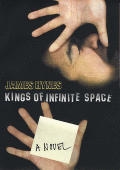Ludology Meets Narratology is an essay on the “similitude and differences between (video)games and narrative.” He argues for a theory of games (ludology) as games, and discusses play and games in terms of narrative.
Wilson: Aesthetics and Practice of Designing Interactivity
The Aesthetics and Practice of Designing Interactive Computer Events is an online paper by Stephen Wilson that has a nice tour through disciplines discussing interactivity from psychology to anthropology. Wilson tackles interactivity by considering what is non-interactive like a photograph, movie, or book. The difference between interactive and non-interactive has to do with the aesthetic use of choice. Interactive works structure choice into the art. Non-interactive works can be interacted with – but that lies outside the work or author’s control. The other difference is the timing and pace of interactive works. In interactive works timing can be used and they are not linear (typically.)
Continue reading Wilson: Aesthetics and Practice of Designing Interactivity
Interactive Fiction Theory
Toward a Theory of Interactive Fiction by Nick Monfort (2003) is an excellent and thorough paper on Interactive Fiction. A lot of what it does is define terms.
Continue reading Interactive Fiction Theory
System Mimicry
WebSE – System 7.0 – Test Drive a Macintosh… is a site that has a Flash (?) simulation of the Apple Macintosh System 7.0 on an SE. I think we will see more of these as ways of preserving the culture of computing. This project should be expanded to a MAME type project for old operating systems. We build on SWF a simulation engine with which to create interactive simulations of old environments.
(Added on May 27, 2004) Thanks to St?©fan Sinclair, here is another simulation of an old Mac. P.dro Classic emulates not just the screen, but has a mouse that moves on a pad and post-it notes. An interesting idea that isn’t executed completely. I could be wrong, but some parts of the emulation are wrong. It is also marred by an unnecessary folder of low-rez porn. This appears to be more of an exercise in nostalgia than a serious attempt to capture the experience of an early Mac.
Continue reading System Mimicry
Hackers and Painters
Embracing the Art of Hacking is a review of a book coming out from O’Reilly called Hackers & Painters. (Thanks to Matt Patey for this reference.)
The similarities and differences between art and programming are hopefully worked out beyond the platitude that “programming is an art.” Art is much more than an “art” in the sense of something that can’t be reduced to rules. Just about everything is a small-a art from cooking to dishwashing. To argue that programming is an Art one would have to look at the practices of training, production and consumption. While I doubt the cultures are that similar at the moment, I expect that programming jobs in North America are going to be increasingly in the entertainment area (from games to special effects) and thus programming as a practice will expand our configurations of the arts.
Kings of Infinite Space
 Kings of Infinite Space by James Hynes (St. Martins Press, 2004) is a brilliant book that reminds me of that other Texas surreal, Vernon God Little.
Kings of Infinite Space by James Hynes (St. Martins Press, 2004) is a brilliant book that reminds me of that other Texas surreal, Vernon God Little.
Kings takes place in Lamar Texas (Austin?) where Paul, a failed academic, has ended up as a temp in the TxDoGS (Texas Department of General Services) writing an never-ending RFP. The novel is part academic fiction and part science fiction as TxDoGS turns out to be haunted by homeless men downsized over the years who will do work in return for sacrificial offerings. “Are we not men?” is the call of the pale men in frayed shirts with pens in their pockets.
While computers and technology doesn’t feature prominently in the book, one read of it is that it is about the side effects of technology – the outsourcing, the downsizing of services, and the cruel neocon dystopia that wastes lives.
Continue reading Kings of Infinite Space
Web Writing and Patterns
Resources at† Hot Text — Web Writing that Works is a project by “The Communication Cirle” (which looks like a writing and consulting company) that has some good stuff on writing for the web. I am intrigued by how they present genres as the writing equivalent to patterns. (See their section on Patterns.) Could it be that genre theory could be applied to the discussion in computer science on patterns?
Continue reading Web Writing and Patterns
Carolyn Guertin: Web.Arts
Carolyn Guertin is a web artist and scholar who is at the University of Alberta. She has written a number of orginal hypertext/hypermedia works which touch on issues of cyberfeminism, design aesthetics, and electronic literature. Check them out.
BeeHive Hypermedia Journal
BeeHive Hypertext/Hypermedia Literary Journal is a neat journal that publishes hypertext/hypermedia works. It started in 1998 and has a fair amount of content some of which works and some not.
Text Vectors
Most text analysis techniques present a synchronic view of the text. For example, a list of word frequencies treats the text as a whole. How can we look at change across a text? How can we quantify a text as it progresses, whether in writing or playing? Could we anticipate the sorts of words likely to be used or summarize those used before?
Continue reading Text Vectors